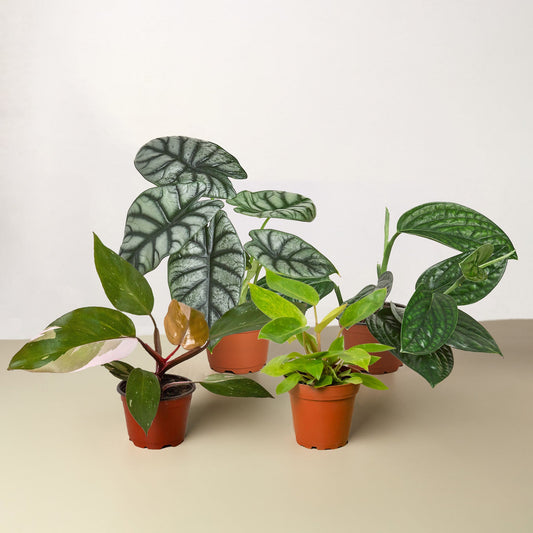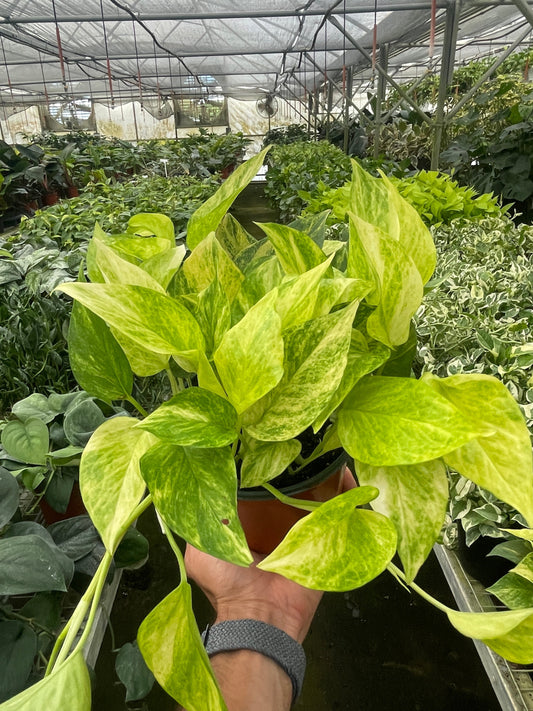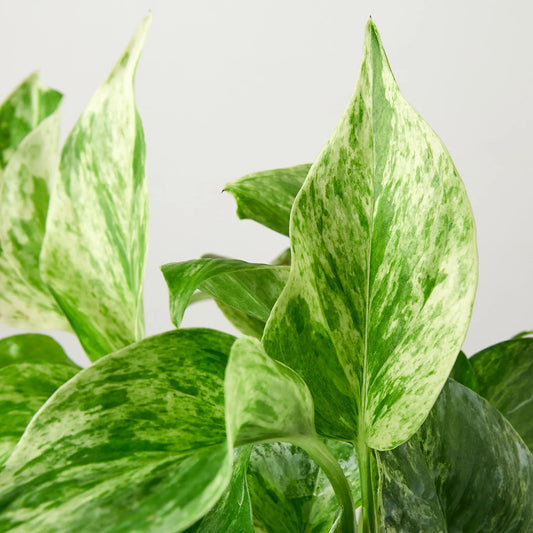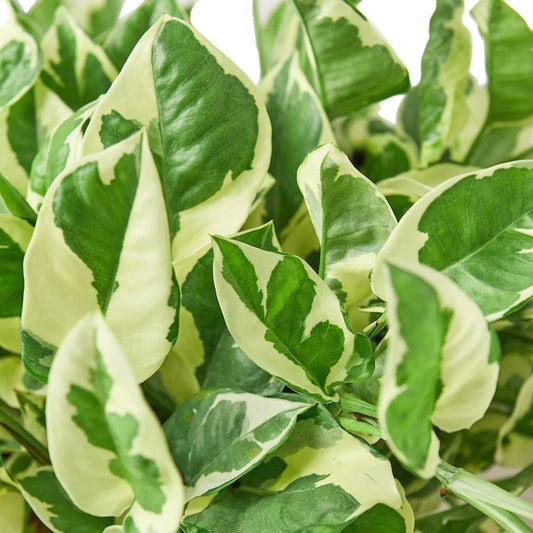Monstera Subpinnata Aerial Roots: Everything You Need to Know
Cafe Planta Team
Monstera Subpinnata is a beautiful addition to any indoor plant collection. With its uniquely split leaves and vibrant green color, it can bring a touch of the tropics into your home. But if you're new to this plant, you might be curious about those long, mysterious aerial roots that seem to have a mind of their own.
In this post, we’ll take a closer look at everything you need to know about Monstera Subpinnata aerial roots. We’ll cover what they are, why they’re there, how to care for them, and even how they can be a part of your interior design. Let’s get started!
What Are Aerial Roots?
Aerial roots are a unique adaptation found in several plant species, and Monstera Subpinnata is no exception. Unlike the roots we typically think of, which grow underground and absorb water and nutrients from the soil, aerial roots grow above the ground.
These roots are usually thick and woody, emerging from the stem of the plant. While they might look a bit wild, they serve essential functions for the plant. In their natural habitat, these roots help the Monstera anchor itself to trees and other structures, allowing it to climb towards the light. This climbing habit is why many Monstera plants, including the Subpinnata, thrive with some structural support indoors.
Interestingly enough, aerial roots can also absorb moisture from the air, which is especially handy in the humid environments these plants naturally inhabit. So, if you notice these roots growing larger or more numerous, your plant might be trying to tell you something about its environment!
Why Does Monstera Subpinnata Have Aerial Roots?
The primary purpose of aerial roots in Monstera Subpinnata is support. These roots act as anchors, helping the plant stabilize itself as it grows taller. In the wild, these roots wrap around trunks and branches, enabling the plant to climb and reach sunlight more effectively.
Another crucial role of aerial roots is moisture absorption. In a rainforest setting, the air is rich with humidity, and aerial roots can help the plant absorb additional moisture. This ability is less pronounced indoors, but it’s still a fascinating trait that highlights the Monstera’s adaptability.
These roots can also help with nutrient absorption. When a Monstera’s aerial roots come into contact with organic matter, they can absorb nutrients, supplementing what the plant draws up from its primary roots. This extra source of nutrients can be beneficial, especially in environments where the soil might not be as nutrient-rich as in the plant’s native habitat.
Do You Need to Trim Aerial Roots?
A common question among plant lovers is whether they should trim their Monstera's aerial roots. The short answer is: it depends on your personal preference and the plant's health. Let’s break it down.
If the aerial roots are becoming too unruly or are causing issues with your space, you can trim them back. It’s important to use clean, sharp scissors or pruning shears and make clean cuts to avoid damaging the plant. However, trimming is not necessary for the plant’s health, and some plant people prefer to leave the roots as they are.
On the other hand, if you enjoy the natural look and the roots aren’t causing problems, you can let them grow. Some plant parents even use the aerial roots as part of their interior design, incorporating them into trellises or other supports to give the plant a more natural, wild look.
Ultimately, the choice is yours, and it won’t significantly impact your Monstera’s health either way. Just be sure to keep an eye on the plant to ensure it’s not becoming top-heavy or unstable if you decide to let the roots grow.
How to Care for Aerial Roots
Caring for Monstera Subpinnata’s aerial roots is relatively straightforward, but there are a few tips to ensure they’re healthy and beneficial to the plant.
- Humidity: Since aerial roots absorb moisture from the air, maintaining adequate humidity levels can help keep them healthy. Aim for a humidity level of around 60% or higher if possible.
- Support: Provide a trellis or a moss pole for your Monstera to climb. This support will give the aerial roots something to anchor to, mimicking their natural habitat.
- Cleaning: Occasionally wipe down the aerial roots with a damp cloth to remove dust and debris. This cleaning helps the roots breathe and function properly.
- Avoid Overwatering: While aerial roots can absorb moisture, overwatering can lead to root rot. Ensure your Monstera’s soil is well-draining and allow it to dry out between waterings.
By providing these simple care measures, you can keep your Monstera’s aerial roots healthy and robust, supporting the plant’s overall growth and well-being.
Incorporating Aerial Roots into Interior Design
One of the most exciting aspects of growing Monstera Subpinnata is the opportunity to integrate its aerial roots into your home’s design. These roots can add an element of intrigue and natural beauty to any room.
Consider using a moss pole or a trellis to guide the roots and stems. This setup not only supports the plant but also creates a striking vertical element in your space. You can also let the roots cascade down from a hanging planter, adding a touch of the wild to your interior.
For those who love to get creative, try weaving the roots around an art piece or a piece of driftwood. This approach can create a dynamic focal point in your room, drawing attention to the unique beauty of your Monstera.
Remember, the key to incorporating aerial roots into your design is balance. You want the roots to complement your space without overwhelming it. Experiment with different supports and arrangements until you find a look that feels right for your home.
Common Issues with Aerial Roots
While aerial roots are generally easy to care for, they can sometimes present a few challenges. Let’s look at some common issues and how to address them.
- Dryness: If the aerial roots appear shriveled or dry, it might indicate low humidity. Increasing the humidity in your home or misting the plant can help.
- Overgrowth: If the roots are growing too long or becoming tangled, consider trimming them back to maintain a tidy appearance.
- Pests: Occasionally, pests like spider mites can affect aerial roots. Keep an eye out for any signs of pests and treat them promptly with neem oil or insecticidal soap.
- Rot: Overwatering can lead to root rot, even in aerial roots. Ensure your Monstera’s soil drains well and avoid letting the plant sit in water.
By keeping an eye on these potential issues, you can ensure your Monstera’s aerial roots remain healthy and vibrant.
Benefits of Aerial Roots
Aerial roots offer several benefits that might not be immediately obvious. Beyond supporting and stabilizing the plant, these roots can contribute positively to your indoor environment.
Firstly, they can help with air purification. Like all plants, Monstera Subpinnata absorbs carbon dioxide and releases oxygen, helping to improve air quality. The more surface area a plant has (including aerial roots), the more effective it is at this process.
Additionally, aerial roots add a sense of vitality and growth to a space. Watching how these roots grow and change over time can be a rewarding experience for any plant lover, adding a dynamic element to your indoor garden.
Finally, they can serve as a conversation starter. Guests might be intrigued by the unique appearance of your Monstera, giving you the perfect opportunity to share your passion for plants and perhaps inspire others to become plant parents themselves.
Training the Aerial Roots
If you’re looking to train your Monstera’s aerial roots, you’re in for a fun and creative project. Training these roots can help you control their growth direction and ensure they integrate seamlessly with your home’s design.
To start, decide on the structure you want your Monstera to climb. This structure could be a moss pole, a trellis, or even a wall-mounted support. Once you’ve chosen, gently guide the aerial roots towards the structure. You can use plant ties or soft string to secure them in place, but be sure not to tie them too tightly, as this could damage the roots.
As the plant grows, continue to guide and secure the roots as needed. This ongoing care helps maintain the desired shape and supports the plant’s overall health.
Training your Monstera’s aerial roots can be a rewarding process, allowing you to shape your plant’s growth and create a unique living art piece in your home.
Creating a Jungle Vibe
If you're dreaming of a lush, jungle-inspired interior, Monstera Subpinnata with its aerial roots can be the perfect centerpiece. Here’s how you can achieve that vibe.
Start by placing your Monstera in a prominent location where it can serve as a focal point. Add other tropical plants with complementary textures and colors around it, such as ferns, philodendrons, and snake plants. This combination creates a layered, harmonious look that mimics a natural jungle environment.
Incorporate natural materials like wood, stone, and woven baskets to enhance the organic feel. You can also use decorative elements like animal figurines or botanical prints to tie everything together.
Pay attention to lighting, as well. Monstera Subpinnata thrives in bright, indirect light, so consider positioning it near a window or using grow lights to simulate its native habitat. This lighting not only benefits the plant but also highlights its unique features, including those stunning aerial roots.
By following these tips, you can transform your space into a green oasis that transports you to a tropical paradise every time you walk into the room.
Final Thoughts
Monstera Subpinnata's aerial roots offer both a practical function and a beautiful design element in your home. From supporting the plant to enhancing its visual appeal, these roots are a fascinating aspect of plant care.
At Cafe Planta, we're here to help you every step of the way. Whether you have questions about plant care or want to explore our collection of unique and popular houseplants, feel free to reach out via email or visit us on Instagram. We believe in the power of plants to connect us with nature and each other. Let's grow together and create beautiful, thriving homes!



















